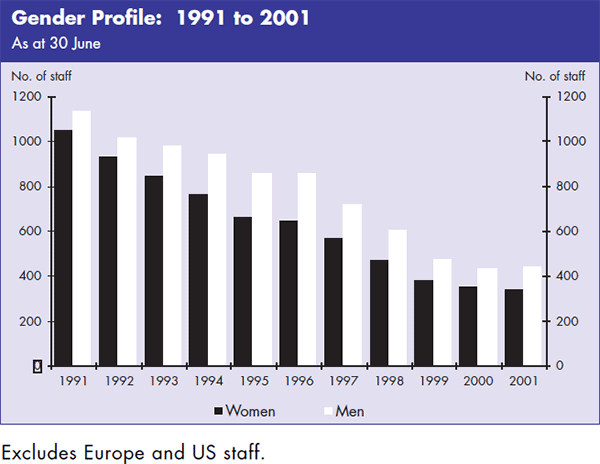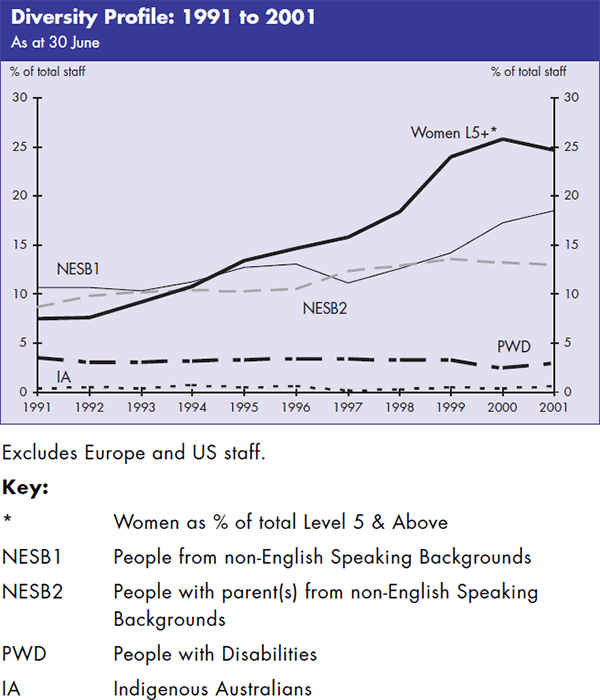Equity & Diversity Annual Report – 2001 Executive Summary
As required by the Equal Employment Opportunity (Commonwealth Authorities) Act 1987, the Bank's EEO program involves the development, implementation and monitoring of an EEO plan.
Staff numbers were relatively steady over the reporting period and the representation of designated EEO groups in the Bank remained similar to last year. Women accounted for 44% of staff. Over the last five years women have increased their representation in professional positions from 22% to 35%. Within the same timeframe, their representation in intermediate clerical positions has declined from 46% to 35%; clerical positions have been impacted most by technology.
There has also been a significant increase in the representation of women at Level 5 & Above, from 8% in 1991 to 25% in 2001. Level 5 & Above as a group has increased from 8% of total staff to 21% of total staff over the same period. Of particular note, of all women in the Bank in 1991, 1% were in the Level 5 & Above group; in 2001, 12% of all women were in this group. In comparison, the representation of men for the same group was 15% of all men in 1991 and 28% in 2001.


There has also been increased representation of people from a non-English speaking background; this group now accounts for 31% of staff compared to 19% ten years ago. People with disabilities have maintained a fairly low representation as have Indigenous Australians, despite the Bank actively seeking such applicants during recruitment drives.
Indigenous Australians (IA) includes Aboriginal people and Torres Strait Islanders, in previous reports this designated group was referred to as ATSI.
The representation of people with disabilities is probably understated as a number of disabilities are often acquired with age and are not usually notified to an employer after recruitment. The Bank's data relies on completion of an EEO Appointment Form to maintain relevant statistics on the designated groups.
The Bank is currently investigating the National Indigenous Cadetship program to encourage indigenous graduates to consider the Bank as a career option.
During the year there was an opportunity for staff to update their personal details held by the Bank, including educational qualifications. This resulted in an increase in the number of staff recorded as having post-secondary/tertiary qualifications from 39% last year to 54% this year. Study assistance was provided to 9% of Bank staff and, for the first time in reporting history, equally to women and men. More than half of all staff attended some form of internal and external training during the year.
Paid parental leave was utilised by 4% of women and 3% of men during the year. 84% of women returned to work after completing parental leave; of these 79% worked part-time. During the next reporting period the take-up of flexible work options available to women after returning from parental leave will be analysed. The purpose of the analysis will be to ascertain the impact of the amended parental leave arrangements that guarantee six months part-time work upon returning to the workplace after 12 months parental leave. This year part-time work was approved for 5% of staff.
The Bank maintains its commitment to an equitable and diverse workplace free from discrimination and harassment. Merit is the key principle in staffing decisions. Policies and practices are constantly under review to ensure equal opportunity for all staff. During the year it was agreed to review a number of employment-related policies as part of a new Enterprise Agreement. These include streamlining part-time work arrangements to improve their flexibility and changes to the merit selection process to enhance its efficiency. The Bank continued investigations into the practicalities of providing some limited childcare opportunities for staff via salary sacrifice. The Bank's programs for recruiting cadets, graduates and trainees were also enhanced to add to their effectiveness in attracting high quality staff to the Bank.